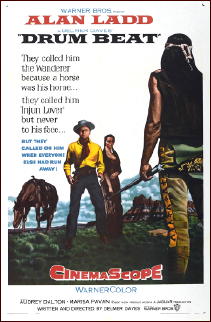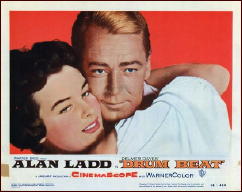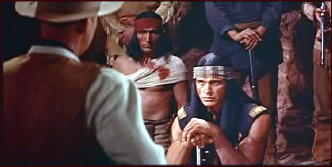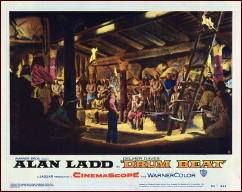Sat 25 Oct 2014
A Western Movie Review by Jonathan Lewis: DRUM BEAT (1954).
Posted by Steve under Reviews , Western movies[5] Comments
DRUM BEAT. Warner Brothers, 1954. Alan Ladd, Audrey Dalton, Marisa Pavan, Robert Keith, Rodolfo Acosta, Charles Bronson, Warner Anderson, Elisha Cook Jr. Screenwriter-Director: Delmer Daves.
If you’re not a Charles Bronson fan, you’re probably not going to care for Drum Beat all that much. If you are a Bronson fan, however, you’re in for a real treat in this extraordinarily scenic CinemaScope Western. Most of the movie is filmed outdoors and there are some great naturalistic settings.
Directed by Delmer Daves, the film’s top billed star is Alan Ladd, who portrays Johnny MacKay, an “Indian fighter.†His mission: bring peace between white settlers and Indians in southern Oregon, not far from the California border. His opponent is Captain Jack (Bronson), a renegade Modoc warrior whose arrogance, intransigence, and ruthlessness is on full display.
But make no mistake about it: Bronson steals the show in this one. He is a wild man, nearly as untamable as the natural settings in which he lives and breathes. But if anyone can break Captain Jack’s reign of terror it is going to be MacKay. So we know from the get go we’re in for an eventual showdown between the two men. And what a showdown it is! The two rivals eventually go at it in hand-to-hand combat as they cascade down a river. It’s but one extremely well filmed action scene in a movie replete with harrowing, often quite shockingly violent, action sequences.
Skilled character actor Robert Keith, who was simply brilliant as a criminal in The Lineup, which I reviewed here, portrays a settler seeking vengeance against the Modocs, while Irish-born actress Audrey Dalton portrays Nancy Meek, Johnny MacKay’s love interest. Their romance just doesn’t feel all that real, but is in many ways, a necessary ingredient in the overall plot.
Drum Beat isn’t without its flaws. The film does at times feel just a bit too predictable. At times, it also seems to borrow too heavily from John Ford’s classic, Fort Apache (1948). There’s even a scene in which MacKay tells a Calvary officer that, even though they aren’t visible, the Indians are certainly hiding in the rocks. John Wayne’s character famously said almost exactly the same thing to Henry Fonda’s character in that earlier film. There’s also the matter of the double cross, although in Drum Beat, it’s the Indians, not the Whites, who are the duplicitous ones.
All that being said, Drum Beat is a certainly an above average Western. The film’s best moment is when MacKay and Captain Jack meet in a Modoc dwelling early on in the film. It’s an exceptionally well-filmed scene and is an example of great staging. It certainly places the emphasis on these two characters. The struggle, tension, and grudging admiration between these two fighters make this somewhat lesser known Western worth a look.




October 25th, 2014 at 8:17 pm
While this one takes a few liberties with the historical record in regard to Captain Jack and the Modoc uprising it is closer to the truth than you might think and Bronson (who steals the film) plays Jack much as he seems to have been (even wearing the murdered general’s jacket in defeat).
That double cross is an infamous fact that happened almost exactly as depicted in the film, with much the same result. Captain Jack was a cold blooded murderer who seems to have had murder more than peace or his people’s welfare on his mind.
I’m not sure the Modoc’s even today see him as anything else considering what he cost them. I know many Indians today, some activists, who have no love for Captain Jack or Geronimo who both set their cause back and cost many Indian lives (this program keeps capitalizing Indian which it should not be in reference to Native Americans, but I don’t feel like arguing with it, only East Indian is capitalized since Indian is not a accurate designation for Native Americans).
I don’t think the FORT APACHE similarities were deliberate, for one thing that line about not seeing the Indians is in every western with Indians dating back to Ford’s silent days and THE IRON HORSE. It’s impossible to make a western that doesn’t reference Ford.
Incidentally ‘Indian fighter’ was a legitimate designation given any number of scouts and civilian militia types such as Ladd and Keith’s character (he stands out here too). As in the film many such ‘Indian fighters’ later became peace makers and advocates for some tribes. They were among the few people to have some idea what the Indians faced under restrictive treaties.
The pacifist do gooder is less about the old west than the fact this was made after the Second World War and ‘peace in our time.’ He’s more Neville Chamberlain than the real man.
I like the scene you single out, but I would hold the scene at the end when Ladd says goodbye to Captain Jack before the hanging is the standout. Bronson and Ladd both shine in that final scene.
Ladd’s struggle with becoming a peacemaker is well handled here.
Agree about the romance with Dalton, but since Pavan’s character Toby actually existed (though no Pavan in looks) and was a Modoc heroine they had to have some romantic interest in the film.
For all the fictionalized bits this film is more accurate historically than most.
April 25th, 2020 at 2:58 pm
Southern Oregon? My foot! This is the great Mohave Desert, the Mogollon Rim, and Apache country. How very juvenile, or maybe greedy, the producers of this trash film showed themselves to be.
January 28th, 2021 at 10:10 am
Unless I am in the staking, Toby lived after the events of the movie and was not killed as shown in the Film.
January 30th, 2021 at 9:30 pm
In fact the Captain Jack stronghold is in northern California near the town of Tulelake. I spent some time there as a youngster.
March 9th, 2024 at 3:45 pm
I was much impressed by the acting of Alan Ladd in this film: in my view it was even better than that in “Shane,” and was part of a career-path in the 1950s which showed he had considerably more ability than his earlier, publicity-saturated career had shown. It is a pity that he wasn’t previously given adequate space to demonstrate his capacity–a fact probably connected with lack of personal influence in the making of the earlier films. Finally, the film was one of several important ones in the 50s to present the complexities of the confrontation between native Americans and white Americans in the c19–and hence the complexities of the native American context.
Tom Rubens.